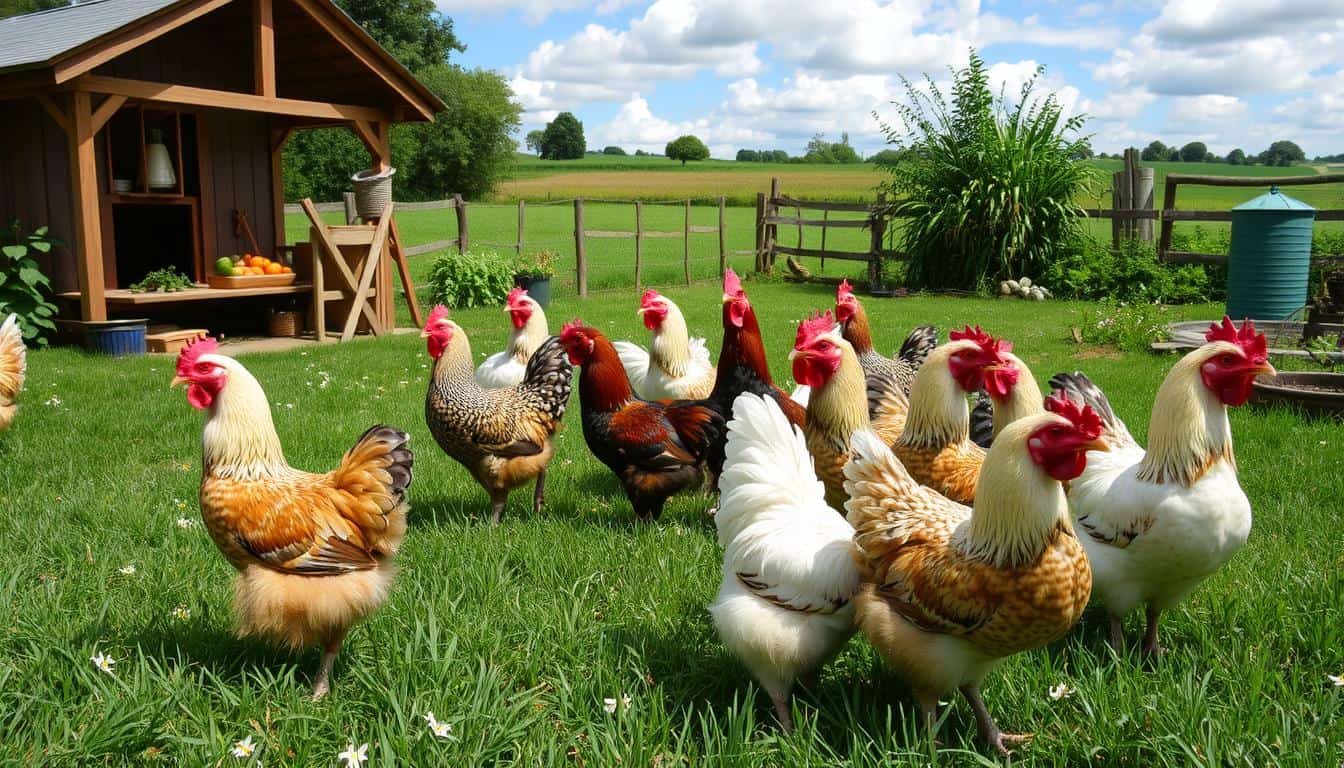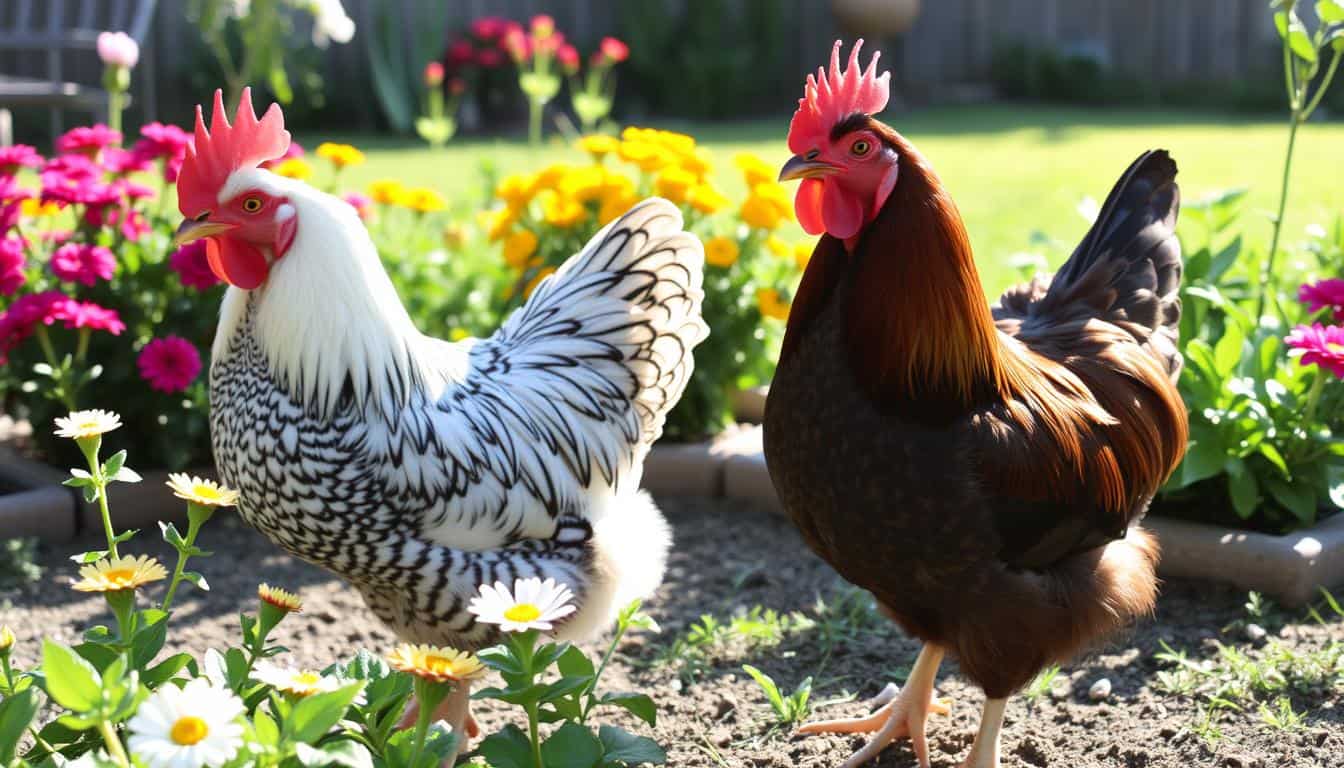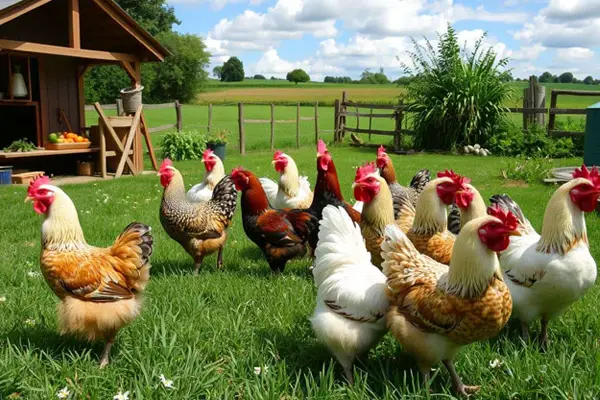Brahma Chicken Care Tips & Facts for Enthusiasts
Did you know Brahma chicken can grow really big? Some can weigh over 12 pounds due to their size, making them one of the largest chicken breeds. These gentle giants have won the hearts of many poultry lovers. They are loved for their size and friendly nature.
We want to share lots of tips and facts about Brahma chickens. This includes how to care for Brahma hens and chicks. We hope to help you learn how to care for these amazing birds.
By learning about their history and special traits, you’ll get better at caring for them. Whether you’re new to chicken keeping or have been doing it for a while, knowing about Brahma chickens will make caring for them more rewarding.
Introduction to Brahma Chickens
Brahma chickens have won the hearts of many since they came to the United States in the 1850s, including both the dark Brahma and light Brahma varieties. They come from Shanghai and are known as “gentle giants.” This is because they are big and very friendly.
They are easy to get along with, making them perfect for both new and experienced chicken keepers. Brahma chickens are great for any backyard. They give us meat and eggs and add a calm touch to our homes, much like a gentle rooster.

They are also very impressive to look at. This makes them a top pick for anyone wanting to raise backyard chickens.
In this section, we will look at what makes Brahma chickens special. We will see why they are a great choice for those who love poultry. Whether you want friends or eggs, Brahma chickens are a standout choice.
| Feature: The dark Brahma variety is particularly known for its striking appearance. | Description |
|---|---|
| Origin | Imported from Shanghai, China in the 1850s |
| Size | Large stature, typically weighing 8-12 pounds |
| Egg Production | Known to lay medium to large brown eggs |
| Temperament | Docile and friendly, great for families |
| Adaptability | Thrives in various climates and settings |
Understanding the Brahma Chicken Breed
The Brahma chicken breed has a rich history and interesting traits. They come from the Brahmaputra Valley in India. In the mid-1850s, they were brought to the United States.
These birds quickly became popular among poultry lovers. An exhibition with Queen Victoria showed off their size. This event helped make them famous for eggs and meat.
Origin and History of Brahma Chickens
In the 1850s, Brahma chickens arrived in the United States. Their journey shows their connection to both the East and West. American farmers were drawn to their size and usefulness.
They were marketed for both eggs and meat. Brahmas gained fame at poultry shows. Queen Victoria’s interest made them even more popular.
Physical Characteristics and Varieties
Brahma chickens are known for their large size and striking looks. They can weigh up to 12 pounds. Their feathered legs and unique appearance make them stand out as one of the largest breeds of chickens.
There are three colour varieties: Light, Dark, and Buff Brahma. Each variety has its own beauty. They all have well-proportioned bodies and a majestic pea comb.
Temperament and Behavior of Brahmas
Brahma chickens are known for being friendly and calm. They are great for families looking for pets. Their gentle nature makes them easy to get along with.
They are friendly to everyone, making them perfect for families. Whether you’re new to chicken keeping or experienced, Brahmas are a great choice.
| Characteristic | Details about the Brahma chickens include their docile nature and ability to go broody. |
|---|---|
| Origin | Brahmaputra Valley, India |
| Imported to the US | Mid-1850s |
| Colour Varieties | Light, Dark, Buff |
| Weight | Approximately 12 lbs |
| Temperament | Docile and calm |
| Unique Features | Feathered legs, pea comb |
Brahma Chicken Care Essentials
To keep our Brahma chickens happy and healthy, we need to focus on their housing and food. These big birds need the right place to live and a balanced diet. This helps them stay healthy and productive, ensuring a good yield for breeders.
Housing Requirements for Brahma Chickens
Good housing is key for Brahma chickens’ health. They are big and have lots of feathers, including on their feet. So, they need lots of room in their coop.
It’s best to give them at least 4 square feet inside and 10 square feet outside. Also, the coop should have strong ventilation for air to flow well. Keeping them safe from bad weather is also important.
Feeding and Nutrition for Optimal Health
For our Brahma chickens to stay healthy, we need to feed them well. They should eat grains, seeds, and proteins. This helps them lay lots of big brown eggs.
Using a layer feed and adding fresh fruits, veggies, and treats like mealworms is good. A varied diet gives them all the vitamins and minerals they need. This supports their growth, egg-laying, and overall health.

Benefits of Raising Brahma Chickens
Raising Brahma chickens, especially the light Brahma variety, has many benefits. They are great for backyard farmers and families. These birds are good at laying eggs and are friendly, making them perfect for families.
Egg Production and Size
Brahma hens lay a lot of eggs. They don’t lay eggs fast, but they lay 3 to 5 large eggs a week, which is impressive for a meat breed. These eggs are rich and brown, adding a lot to our backyard flock.
The eggs they lay are reliable. This makes Brahmas a great choice for any backyard flock.
Meat Production and Quality
Brahmas are also great for meat. They grow big, up to 12 pounds or more, especially the dark Brahma variety. This means their meat is flavorful and high quality, making them ideal chickens for meat.
They are perfect for those who like farm-to-table food. Brahmas make great broilers.
Docile Nature and Family Companionship
Brahma chickens are very friendly and calm, making them great companions for any breeder. They fit well into families with kids and pets. Their friendly nature helps everyone get along.
They bring joy and comfort to our homes. Brahmas are not just productive but also bring happiness.

Challenges of Caring for Brahma Chickens
Caring for Brahma chickens comes with its own set of challenges. We must watch their health closely to keep them happy and healthy. Regular health checks are key to spotting and fixing common problems.
Health Concerns to Monitor
Brahmas, like any chicken, can get sick. They might have breathing issues, feather problems, or parasites. Keeping their home clean is vital to stop these issues. Here are some health tips:
- Look for signs of sickness or odd behavior
- Clean their coop often to avoid disease
- Take them to the vet for early checks
- Follow vet advice on vaccinations
We can help our Brahma chickens stay healthy by watching for these health issues.
Adaptation to Climate and Weather
Brahma chickens are good at handling cold weather. Their big size and feathers help them stay warm. But they struggle in the heat. To keep them comfortable in bad weather, we should:
- Give them shade when it’s hot
- Make sure they always have fresh water
- Watch for signs of heat stress
Knowing how they adapt to weather helps us create a better home for these Brahma’s. Here’s a table with important health and environment tips for Brahma chickens:
| Factor | Cold Weather | Hot Weather |
|---|---|---|
| Temperature Range | Well Adapted | Poor Adaptation |
| Health Risks | Lower Risk of Respiratory Issues | Higher Risk of Heat Stress |
| Essential Care | Insulation and Bedding | Shade and Hydration |
Tips for Raising Healthy Brahma Chickens
We must take good care of these fowl to keep our Brahma chickens healthy and happy. We should follow routine care and management practices. This helps their wellbeing and makes our time with them enjoyable.
Routine Care and Management Practices
Having a daily routine is key for Brahma chickens’ health. We should:
- Feed them at the same times every day.
- Clean their coop often to keep it clean and ensure a healthy environment for the fowl.
- Check their health regularly to spot problems early.
By watching their behaviour and health, we can quickly fix any problems. This keeps our flock happy and healthy.
Socialization within the Flock
Brahmas love to be around others. Socializing them is very important. We should do it slowly when we add new birds to avoid stress.
Slow introductions help everyone get along better. Having the right number of birds in the flock also helps. It makes for a healthier and happier group.
Breeding and Raising Brahma Chicks
If you want to breed, you need a good incubator. It helps more chicks hatch successfully. After they hatch, we must feed and socialize them well.
Good food and gentle care help them grow into healthy adults. Raising chicks is a big job, but it’s very rewarding.
| Aspect | Importance | Tips |
|---|---|---|
| Routine Care | Maintains health and wellbeing | Daily feeding, coop cleaning, health checks |
| Socialization | Reduces stress, enhances flock dynamics | Gradual integration of new birds |
| Breeding | Ensures healthy future generations | Use a reliable incubator and focus on chick care |
Conclusion
Brahma chickens bring many benefits to our lives. They are gentle and provide eggs regularly. Their size and looks add elegance to our coops.
Knowing how to care for Brahma chickens is key. This lets us keep them healthy and happy. Whether we want eggs, meat, or friends, they can be great additions.
Adding Brahma chickens to our lives makes backyard poultry better. They are calm and useful. Keeping chickens brings joy and rewards, thanks to these amazing birds.
Read More🐦Related Articles:
| What Do Owls Eat |
| Ducks in Hawaii |
| Hummingbirds in Maryland |
| Discover the Stunning Red-Breasted Goose |
| Ducks in Georgia |
Frequently Asked Questions About Brahma Chicken
Q1. Are Brahma chickens friendly?
Yes, Brahma chickens are known for their calm and friendly temperament.
Q2. How long do Brahma chickens live?
They typically live about 5 to 8 years, with some living longer with good care.
Q3. How many eggs does a Brahma chicken lay?
Brahma chickens usually lay about 3-4 eggs per week.
Q4. When do Brahma chickens start laying eggs?
They generally start laying eggs around 5 to 6 months of age.
Q5. How tall are Brahma chickens?
Brahma chickens can stand about 2.5 to 3 feet tall, depending on the individual bird.







